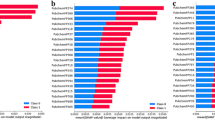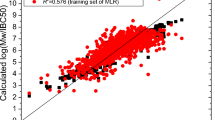Abstract
In vivo micronucleus assay is the widely used genotoxic test to determine the extent of chromosomal aberrations caused by the chemicals in human beings, which plays a significant role in the drug discovery paradigm. To reduce the uncertainties of the in vivo experiments and the expenses, we intended to develop novel machine learning-based tools to predict the toxicity of the compounds with high precision. A total of 372 compounds with known toxicity information were retrieved from the PubChem Bioassay database and literature. The fingerprints and descriptors of the compounds were generated using PaDEL and ChemSAR, respectively, for the analysis. The performance of the models was assessed using the three tires of evaluation strategies such as fivefold, tenfold, and validation by external dataset. Further, structural alerts causing genotoxicity of the compounds were identified using SARpy method. Of note, fingerprint-based random forest model built in our analysis is able to demonstrate the highest accuracy of about 0.97 during tenfold cross-validation. In essence, our study highlights that structural alerts such as chlorocyclohexane and trimethylamine are likely to be the leading cause of toxicity in humans. Indeed, we believe that random forest model generated in this study is appropriate for reduction of test animals and should be considered in the future for the good practice of animal welfare.



Similar content being viewed by others
Data Availability
Code Availability
Not applicable.
References
Basu, A. K., & Nohmi, T. (2018). International Journal of Molecular Sciences, 19(4), 970.
Eastmond, D. A., Hartwig, A., Anderson, D., Anwar, W. A., Cimino, M. C., & Dobrev, I. (2009). … and Vickers, C. Mutagenesis, 24(4), 341–349.
Kang, S. H., Kwon, J. Y., Lee, J. K., & Seo, Y. R. (2013). J. Cancer. Prev., 18(4), 277.
Van Bossuyt, M., Raitano, G., Honma, M., Van Hoeck, E., Vanhaecke, T., & Rogiers, V. (2020). … and Benfenati, E. Toxicology Letters, 329, 80–84.
Kamath, P., Raitano, G., Fernández, A., Rallo, R., & Benfenati, E. (2015). SAR and QSAR in Environmental Research, 26(12), 1017–1031.
Benigni, R., Bossa, C., & Worth, A. (2010). Mutagenesis, 25, 335–341.
Khalifa, N., Kumar Konda, L. S., & Kristam, R. (2020). Future. Medicinal Chemistry, 12(20), 1829–1843.
Chen, X., Dang, L., Yang, H., Huang, X., & Yu, X. (2020). RSC Advances, 10(59), 36174–36180.
Lavecchia, A. (2015). Drug Discovery Today, 20(3), 318–331.
Wu, Y., & Wang, G. (2018). International Journal of Molecular Sciences, 19(8), 2358.
Fan, D., Yang, H., Li, F., Sun, L., Di, P., & Li, W. (2018). … and Liu, G. Toxicol. Res., 7(2), 211–220.
Wang, Y., Bryant, S. H., Cheng, T., Wang, J., Gindulyte, A., Shoemaker, B. A., ... and Zhang, J. (2017) Nucleic Acids Res. 45(D1), D955-D963.
Bero, S. A., Muda, A. K., Choo, Y. H., Muda, N. A., and Pratama, S. F. (2018) arXiv preprint. arXiv:1806.05237.
Capecchi, A., Probst, D., & Reymond, J. L. (2020). J. Cheminf., 12(1), 1–15.
Mauri, A., Consonni, V., & Todeschini, R. (2016). In Handbook of Computational Chemistry; Leszczynski J (pp. 1–29). Springer.
Wu, Y., Han, C., Liu, J., Han, C., Wang, Z., Gong, L., Liu, J., Chong, Y., Liu, X., Liang, N., & Li, S. (2020). Frontiers in Oncology, 10, 743.
Jiang, C., Zhao, P., Li, W., Tang, Y., & Liu, G. (2020). Toxicol. Res., 9(3), 164–172.
Bhattacharjee, P., Dey, V., and Mandal, U. K. (2020) Saf. Sci. 132, 104967.
Zhou, S., Wang, S., Wu, Q., Azim, R., and Li, W. (2020) Comput. Biol. Chem. 85, 107200.
Wang, J., Deng, F., Zeng, F., Shanahan, A. J., Li, W. V., & Zhang, L. (2020). American Journal of Cancer Research, 10(5), 1344.
Suresh, K. (2020), Advances in artificial intelligence and data engineering, vol. 1133, Advances in Intelligent Systems and Computing (Chiplunkar, N., Fukao, T., eds,), Springer, Singapore, pp. 329–347.
Khairunnahar, L., Hasib, M. A., Rezanur, R. H. B., Islam, M. R., and Hosain, M. K. (2019) Inform. Med. Unlocked. 16, 100189.
Tapak, L., Shirmohammadi-Khorram, N., Amini, P., Alafchi, B., Hamidi, O., & Poorolajal, J. (2019). Clin. Epidemiology Glob. Health., 7(3), 293–299.
Pedregosa, F., Varoquaux, G., Gramfort, A., Michel, V., Thirion, B., Grisel, O., Blondel, M., Prettenhofer, P., Weiss, R., Dubourg, V., Vanderplas, J., Passos, A., Cournapeau, D., Brucher, M., & Duchesnay, E. (2011). Journal of Machine Learning Research, 12, 2825–2830.
Lynch, C. M., Abdollahi, B., Fuqua, J. D., Alexandra, R., Bartholomai, J. A., Balgemann, R. N., van Berkel, V. H., & Freiboes, H. B. (2017). International Journal of Medical Informatics, 108, 1–8.
Cervantes, J., Garcia-Lamont, F., Rodríguez-Mazahua, L., & Lopez, A. (2020). Neurocomputing, 408, 189–215.
Dwivedi, A. K. (2018). Neural Computing and Applications, 29(12), 1545–1554.
Chen, Y., Jia, Z., Mercola, D., and Xie, X. (2013) Comput. Math. Methods. Med. 2013, 873595.
Yang, H., Li, J., Wu, Z., Li, W., Liu, G., & Tang, Y. (2017). Chemical Research in Toxicology, 30(6), 1355–1364.
Wang, G., Sun, Y., Chen, Y., Gao, Q., Peng, D., Lin, H., ... and Zhuo, S. (2020) J. Biophotonics. 13(9), e202000050.
Dong, J., Yao, Z. J., Zhu, M. F., Wang, N. N., Lu, B., Chen, A. F., ... and Cao, D. S. (2017) J. Cheminformatics. 9(1), 1–13.
Alabi, R. O., Elmusrati, M., Sawazaki‐Calone, I., Kowalski, L. P., Haglund, C., Coletta, R. D., ... and Leivo, I. (2020) Int. J. Med. Inform. 136, 104068.
Barlow, H., Mao, S., & Khushi, M. (2019). Data., 4(3), 129.
Ma’ruf, F. A., and Wisesty, U. N. (2019) In Journal of Physics: Conference Series, March, IOP Publishing, 1192(1), 012011.
Han, Y., Zhang, J., Hu, C. Q., Zhang, X., Ma, B., & Zhang, P. (2019). Frontiers in Pharmacology, 10, 434.
Ufnal, M. (2020). Journal of Nutrition, 150(2), 419.
Xu, J., Qiao, X., Cui, M. F., Tang, J. H., & Zhang, J. P. (2005). The Chinese Journal of Process Engineering, 5(6), 643.
Acknowledgements
The authors thank the management of the Vellore Institute of Technology for providing the necessary facility to carry out this research work. We sincerely thank all the anonymous reviewers for their valuable suggestions in the improvement of the manuscript.
Author information
Authors and Affiliations
Contributions
PR performed data collection, machine learning model generation, and validation. SV conceived this study and is responsible for the overall design, interpretation, manuscript preparation, and communication.
Corresponding author
Ethics declarations
Conflict of Interest
The authors declare no competing interests.
Additional information
Publisher's Note
Springer Nature remains neutral with regard to jurisdictional claims in published maps and institutional affiliations.
Supplementary Information
Below is the link to the electronic supplementary material.
Rights and permissions
About this article
Cite this article
Ramesh, P., Veerappapillai, S. Prediction of Micronucleus Assay Outcome Using In Vivo Activity Data and Molecular Structure Features. Appl Biochem Biotechnol 193, 4018–4034 (2021). https://doi.org/10.1007/s12010-021-03720-8
Received:
Accepted:
Published:
Issue Date:
DOI: https://doi.org/10.1007/s12010-021-03720-8




